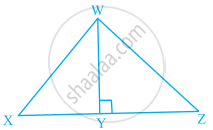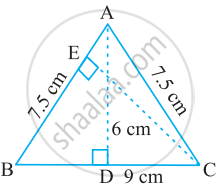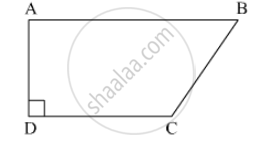Advertisements
Advertisements
प्रश्न
Ratio of the area of ∆WXY to the area of ∆WZY is 3:4 in the given figure. If the area of ∆WXZ is 56 cm2 and WY = 8 cm, find the lengths of XY and YZ.

उत्तर
Given, area of ∆WXZ = 56 cm2
⇒ `1/2` × WY × XZ = 56 ......[∵ area of triangle = `1/2` × base × height]
⇒ `1/2` × 8 × XZ = 56 ......[∵ WY = 8 cm, given]
⇒ XZ = 14 cm
∴ Area of ∆WXY : Area of ∆WZY = 3:4
⇒ `"Area of ∆WXY"/"Area of ∆WZY" = 3/4`
⇒ `(1/2 xx WY xx XY)/(1/2 xx YZ xx WY) = 3/4`
⇒ `"XY"/"YZ" = 3/4`
⇒ `"XY"/("XZ" - "XY") = 3/4` ......[∵ YZ = XZ – XY]
⇒ `"XY"/(14 - "XY") = 3/4` ......[By cross-multiplication]
⇒ 4XY = 42 – 3XY
⇒ 7XY = 42
⇒ XY = 6 cm
So, YZ = XZ – XY = 14 – 6
YZ = 8 cm
Hence, XY = 6 cm and YZ = 8 cm.
APPEARS IN
संबंधित प्रश्न
A(4, - 6), B(3,- 2) and C(5, 2) are the vertices of a 8 ABC and AD is its median. Prove that the median AD divides Δ ABC into two triangles of equal areas.
The coordinates of A, B, C are (6, 3), (–3, 5) and (4, – 2) respectively and P is any point (x, y). Show that the ratio of the areas of triangle PBC and ABC is
Find the area of the triangle whose vertices are: (2, 3), (-1, 0), (2, -4)
The class X students of a secondary school in Krishinagar have been allotted a rectangular plot of land for their gardening activity. Saplings of Gulmohar are planted on the boundary at a distance of 1 m from each other. There is a triangular grassy lawn in the plot as shown in the following figure. The students are to sow seeds of flowering plants on the remaining area of the plot.

(i) Taking A as origin, find the coordinates of the vertices of the triangle.
(ii) What will be the coordinates of the vertices of Δ PQR if C is the origin?
Also calculate the areas of the triangles in these cases. What do you observe?
ΔABC is isosceles with AB = AC = 7.5 cm and BC = 9 cm (see the given figure). The height AD from A to BC, is 6 cm. Find the area of ΔABC. What will be the height from C to AB i.e., CE?

Show that the following sets of points are collinear.
(1, −1), (2, 1) and (4, 5)
Show that the points O(0,0), A`( 3,sqrt(3)) and B (3,-sqrt(3))` are the vertices of an equilateral triangle. Find the area of this triangle.
In ☐ABCD, l(AB) = 13 cm, l(DC) = 9 cm, l(AD) = 8 cm, find the area of ☐ABCD.

Using integration, find the area of triangle ABC, whose vertices are A(2, 5), B(4, 7) and C(6, 2).
Area of a triangle = `1/2` base × ______.
